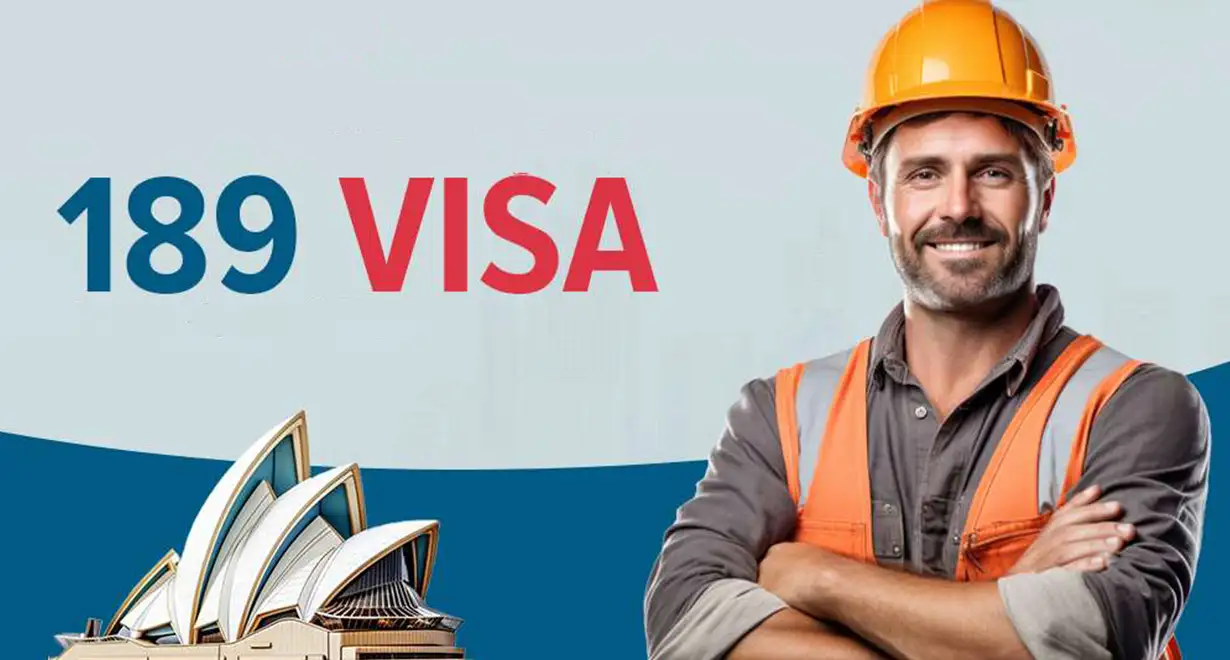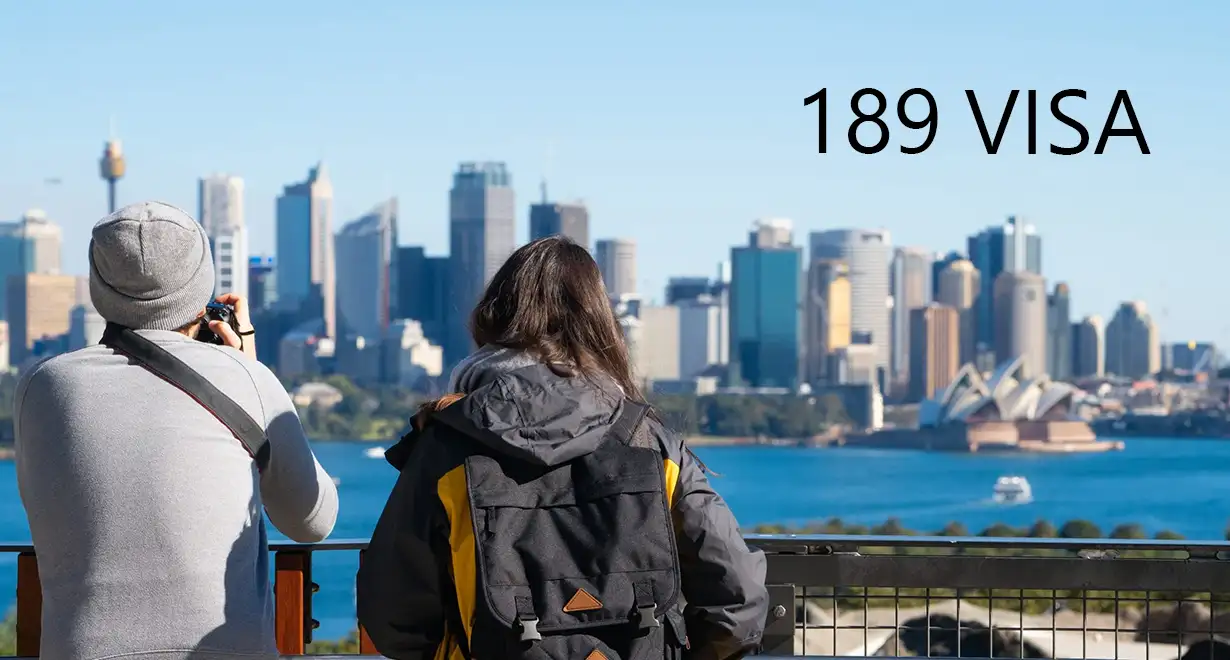Skilled Independent Visa (Subclass 189)
The Subclass 189 visa is designed for individuals who wish to migrate to Australia with their family. Known as the Skilled Independent visa, it does not require sponsorship by the Australian government or any state or territory.
If you are under 45, your occupation appears on Australia’s Skilled Occupation List, and you have scored at least 65 points on the Australian points test, you can apply for this visa independently.
To receive professional immigration consultation, please fill out the form below:
What is the Australia Subclass 189 Visa?
The Australia Subclass 189 visa is a Skilled Independent visa granted to address Australia’s shortage of workers in in-demand occupations by inviting skilled workers from overseas. Being “independent” means that you do not need nomination by an employer, the government, or a state/territory sponsor. Holders and their families can live, work, and study permanently anywhere in Australia.
Benefits of the Subclass 189 Visa
- Permanent residency in Australia from the date the visa is granted
- Permission to live, work, and study anywhere in Australia
- Access to free healthcare services
- Ability to include family members (spouse and dependent children)
- Eligibility to apply for Australian citizenship once requirements are met
- Access to loans and grants for home purchase and education
Conditions Required for Obtaining a Subclass 189 Visa from Outside Australia
- Register in Australia’s points-based system (Skill Select) and submit an Expression of Interest (EOI).
- Score at least 65 out of 100 points and receive an invitation from the Australian government to lodge your visa application.
- Be between 18 and 45 years of age.
- Demonstrate Competent English (equivalent to at least IELTS 6, TOEFL iBT 64, PTE 50, Cambridge 169, or OET B in each band/component).
- Provide a police clearance certificate.
- Hold at least a high school diploma.
- Have at least one year of continuous, full-time work experience in an occupation listed on Australia’s Skilled Occupation List within the last two years.
- Nominate an occupation that appears on Australia’s Skilled Occupation List.
One important point: The most critical requirement for the Subclass 189 visa is that your occupation must appear on Australia’s Skilled Occupation List. The Department of Home Affairs publishes this list annually (though it’s subject to changes throughout the year), and applicants must verify that their occupation is included before applying. To demonstrate your skill, you must submit your credentials to the relevant assessing authority in Australia and obtain a positive skills assessment.
Conditions for Obtaining a Subclass 189 Visa from Within Australia
If you are in Australia when you apply for the Subclass 189 visa, you must hold one of the following:
- A substantive visa (any visa other than a bridging visa, criminal justice visa or enforcement visa).
- Bridging visa A (BVA) – Subclass 010
- Bridging visa B (BVB) – Subclass 020
- Bridging visa C (BVC) – Subclass 030
Important Note for Subclass 491 and 494 visa holders: If you currently hold, or your last substantive visa held was a Subclass 491 (Skilled Work Regional (Provisional)) or Subclass 494 (Skilled Employer Sponsored Regional (Provisional)) visa, you must have held that visa for at least three years at the time you apply for the Subclass 189 visa. However, if your 491 or 494 visa application is still processing and you are on a substantive visa or a bridging visa (A, B, or C), you may be able to apply for the 189 visa without this three-year wait period.
Documents Required for Subclass 189 Australia Visa
All documents must be translated into English and certified by a notary public as true copies:
- Birth certificate, national ID card, valid passport (minimum six months’ validity), and military service card or exemption certificate (for males). Copies and translated versions, if required.
- English language test certificate (IELTS, TOEFL iBT, OET, PTE, or Cambridge).
- Proof of fee payment.
- Marriage certificate (if applicable).
- Passport-style photograph.
- Certificate demonstrating at least one year of continuous full-time work experience within the last two years.
- All employment documents (sample contracts, payment receipts, tax records).
- Employment verification on company letterhead detailing dates, position, duties, and salary, signed and stamped by your employer.
- Payslips, especially for public-sector roles.
- All qualification documents: university degrees, diplomas, and training certificates.
- Positive skills assessment report from the relevant assessing authority (each occupation has its own authority).
- Health and character clearance certificate.
- Police clearance certificates from all relevant jurisdictions.
Steps to Obtain a Subclass 189 Australia Visa
- Check the Australian Skilled Occupation List to confirm your occupation is included.
- Gather all required documents (see list above).
- Submit your educational and employment documents to the relevant assessing authority in Australia and obtain a positive skills assessment.
- Lodge an Expression of Interest (EOI) via SkillSelect. SkillSelect will estimate your points based on the claims in your EOI; you may amend your EOI to improve your score before receiving an invitation.
- If you score at least 65 points, wait for an Invitation to Apply (ITA) from the Australian government. Once you receive the ITA, you have 60 days to compile your documents, pay visa fees, and submit your application.
- Register on the Department of Home Affairs visa application portal after receiving your ITA.
- Log into your account, complete the application form, and upload all supporting documents.
- After submission, the Department of Home Affairs will assess your application and, if approved, grant your Subclass 189 visa.
Cost of the Australia Subclass 189 Visa
Determining the exact cost of migrating to Australia on the Subclass 189 skilled visa can be difficult—your circumstances, number of family members, and other factors will influence the total amount. Below are the Australian government fees for the Subclass 189 visa; fees for migration agents, lawyers, and case follow-up vary and must be calculated separately.
Government Fees (as of July 2025):
- Primary applicant: AUD 4,910
- Dependent aged 18 or over: AUD 2,455
- Dependent under 18: AUD 1,230
- Skills assessment: AUD 300–2,000 (varies by occupation and assessing authority)
- Medical and police clearances: approximately AUD 400-600 per person (can vary by country and specific requirements)
- Second Instalment (if applicable): AUD 4,885 for any applicant 18 years or older with less than functional English. This is only paid if the visa is going to be granted.
Important Notes
- If you sponsor your spouse, children, or stepchildren, you can include them in your application. Once the visa is granted, they enjoy the same rights and privileges as you.
- You and your family must comply with Australian laws and fulfill all visa conditions.
- After your first entry to Australia, your permanent visa generally allows unrestricted entry and exit for five years from the date of visa grant. During this period, you may apply for Australian citizenship if you meet the residency and other requirements (typically living in Australia for four years, with at least the last 12 months as a permanent resident).
- If you do not obtain citizenship within five years and wish to travel outside Australia and re-enter as a permanent resident, you must secure a Resident Return Visa (RRV) for each subsequent re-entry after the initial five-year travel facility on your Subclass 189 visa expires.
Processing Times
- 75% of applications: Processed within 4 to 8 months.
- 90% of applications: Processed within 6 to 12 months.
Note: These are estimated processing times from the Department of Home Affairs and can vary depending on individual circumstances, completeness of the application, and demand for the nominated occupation.
How to Overcome a Subclass 189 Visa Rejection
- Understand the reason for rejection: Pinpoint exactly why your application was refused. The Department of Home Affairs will provide a refusal letter outlining the reasons.
- Consult an expert: Engage an experienced migration lawyer or registered migration agent who can advise you on your options, potential remedies, and guide you through any appeal process.
- Lodge an appeal if appropriate: If you believe the decision was legally incorrect or based on a factual error, and you meet the criteria for appeal, you may be able to apply to the Administrative Appeals Tribunal (AAT) for a review of the decision. Be aware of strict time limits for lodging an appeal.
- Await the Tribunal’s decision: The AAT will review your case. If the AAT sets aside the Department’s decision, it may remit the application back to the Department of Home Affairs for reconsideration, or in some cases, substitute the decision to grant the visa.
- Re-apply (if appeal is not an option or unsuccessful): If an appeal is not possible, or if it’s unsuccessful, you might be able to re-apply for the visa, addressing the issues that led to the initial refusal. This often requires significant changes to your circumstances or a more robust application.
Common Reasons for Subclass 189 Visa Rejection
- Incomplete documentation
- Failure to demonstrate sufficient funds
- Insufficient justification for permanent residency
- Non-compliance with visa criteria
- Applying for the wrong visa subclass
- Providing false information or fraudulent documents
- Having a criminal record
- Unlawful residence in a country other than Australia
Similarities between Subclass 189 and Subclass 190 Visas
Both Subclass 189 and Subclass 190 visas are permanent visas granting indefinite stay in Australia. They both use the points-based system, assessing qualifications, work experience, English proficiency, and age.
Differences between Subclass 189 and Subclass 190 Visas
- Sponsorship: Subclass 190 requires nomination by an Australian state or territory government, whereas Subclass 189 does not.
- Occupation lists: For Subclass 190, your occupation must appear on the nominating state or territory’s specific occupation list; Subclass 189 simply requires inclusion on the national Skilled Occupation List (often the Medium and Long-term Strategic Skills List – MLTSSL).
- Processing times: Historically, Subclass 190 applications were often processed faster than Subclass 189 applications due to the state/territory nomination process, which can filter applications. However, current processing times can vary based on demand, specific occupations, and Department of Home Affairs priorities, so it’s best to check the official DHA website for the most up-to-date information.
Permanent Residency with the Subclass 189 Visa
In this article, we’ve covered the Subclass 189 visa—its conditions, required documents, application steps, and key considerations. As a Skilled Independent visa, it requires no sponsorship but does require a minimum score of 65 points in SkillSelect. By securing the Subclass 189 visa, you gain permanent residency in Australia, the right to live, work, and study anywhere in the country, and the ability to apply for citizenship (and an Australian passport) after meeting the residency requirement.



